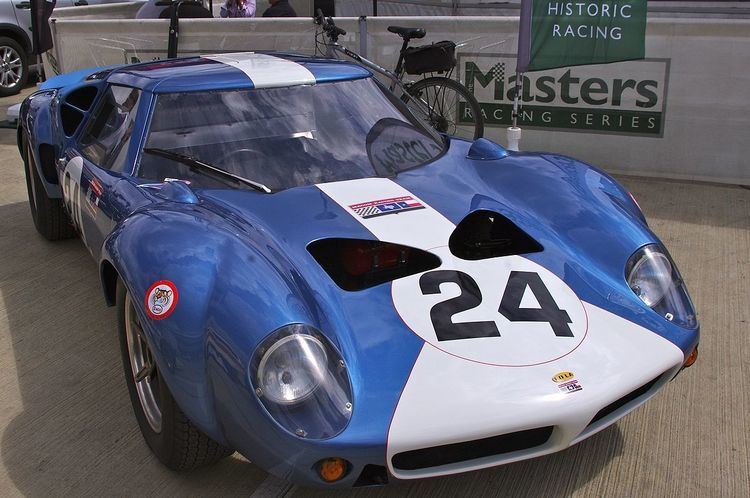Suspension (front) Double wishbones | Successor Ford GT40Lola T70 | |
 | ||
Category Experimental Grand Touring | ||
The Lola Mk6 GT was a racing car built in only three units between 1962 and 1963 by British car manufacturer Lola Cars. With its 289 cubic inches Ford V8 engine it was the first mid-mounted, high displacement V8 engine powered Grand Touring car, a technical solution that had just been introduced on the racing scene, but used until then only on formula cars and smaller and more affordable GTs.
Contents
Development
Mid-engine cars were a revolutionary idea introduced in car racing by Cooper Car Company, a small British firm that managed to beat big players in Formula 1 World Championship twice in a row, but this layout did not make its path into Grand Tourers, which were accepted to race only if a minimum production run had been completed: not a single manufacturer was keen on doing big investments to build cars "at a minimum rate of one hundred identical units as far as mechanical parts and coachwork are concerned in 12 consecutive months", as required by FIA, without having the necessary experience with such applications and the right parts and components.
It is important to say that in those days there was no "off the shelf" transaxle gearbox capable to manage the enormous torque provided by big V8 engines. When Colotti Tipo 37 gearbox was made available to the market after it was specifically built to be mounted on the Lotus 29 single seater, a racing car powered by a 256 cu in (4,195.1 cc) Ford Fairlane V8 and intended to race the 1963 Indianapolis 500, Lola's owner Eric Broadley had the opportunity to solve the problem.
Moreover, FIA's decision to terminate its World Sports Car Championship by replacing it with the new International Championship for GT Manufacturers for 1962 season, in order to focus manufacturer's attention on Grand Tourers, made more difficult for mid-engined GT to make their way into production. But the Federation left an open door to research and development, admitting to races Experimental Grand Touring cars (later known as Prototypes), with no minimum production requirement, but requiring roadworthiness. Lola Mk6 GT was conceived by Eric Broadley at the end of 1962 to be accepted into Experimental Grand Touring class.
Technical description
The Mk6 GT featured some of the best technology of the time, first of all an aluminium monocoque (although the prototype car had a steel monocoque in order to save time), while all opponents - apart from Jaguar - still relied on Space frame chassis. Ford-Colotti engine-gearbox assembly was a stressed member and rear suspensions were mounted directly on it, like on best Formula 1 cars of that time: as a result the car was so compact that wheelbase was even shorter than other Lola's formula cars, despite using a big pushrod 400 CV (298 KW) American V8 engine.
The coachwork, designed by John Frayling and made by FRP, had its own features like reduced overhangs, Kamm-tail, roof-integrated engine air intake and special doors: they extended into the roof to give the pilots greater access to the cockpit once they were open, an idea that was kept on the successor, the Ford GT40.
Racing History
Prototype car (chassis LGT-P) was shown to public in January 1963 at Olympia Racing Car Show in the United Kingdom gaining a big success and great expectations and during following months South African Tony Maggs raced it at Silverstone (finishing fifth starting last on the grid) and at Nürburgring 1000 km (retired for technical reasons), while the second car (chassis LGT-1, aluminium monocoque) was being completed and prepared for 1963 24 Hours of Le Mans.
Short of preparation, Broadley himself brought LGT-1 to Le Mans at the very last moment for technical verifications, that required some modifications to the car. After their completion the car was allowed to race, but the time spent couldn't be used for proper testing: the car raced with the wrong gear ratios, was not able to show all of its potential (pilots didn't go full throttle on the long Mulsanne Straight, to avoid overrevving, with a 30 mph lower than predicted top speed) and was forced to retire after 15 hours by an accident due to a gear selector failure. Understanding the potential performance of the Mk6, Ford Motor Company bought it to further test the car laying the foundation for its GT40 project and involving Broadley himself, who later left the program.
Meanwhile, a third car (chassis #LGT-2), the second aluminium monocoque not raced at Le Mans that year because it not ready, was completed and sold to American Mecom Racing Team that raced it at Brands Hatch, where the Ford engine broke after only four laps. Replaced by a Traco-tuned 6 litre Chevrolet V8 delivering 530 CV (395 KW) at 6500 giri/min, the car was extensively raced in North America and won 1963 Bahamas Speed Week
